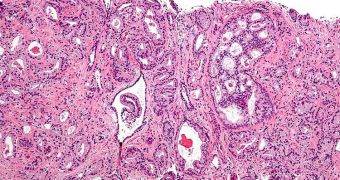A group of investigators at the Cold Spring Harbor Laboratory (CSHL) says that the interplay between two genetic factors underlying the development and evolution of prostate cancer have finally been studied and understood. The findings may help identify those who will develop lethal prostate cancer.
In the United States alone, more than 250,000 men are diagnosed with this disease every single year. Of these individuals, about 1 percent will be diagnosed with the lethal, metastatic form of the disease.
The remaining 99 percent will go on to develop a non-lethal, indolent form of cancer. What oncologists and researchers are trying to do is figure out how to distinguish between these two groups of patients early on, before it's too late for therapies to have any effect.
In the new investigation, CSHL investigators may have taken a new step towards that goal, by identifying a new prostate tumor suppressor gene called PHLPP1. They say that the gene works in concert with the well-studied tumor suppressor PTEN.
Together, the two underly the progression and development of prostate cancer. Details of the new investigation appear in the August 16 issue of the renowned medical journal Cancer Cell.
One of the most interesting things about PTEN, experts say, is that losing one of the two copies the gene has leads to rapid tumor formation. On the other hand, losing both copies triggers senescence, which can be defined as a form of cell growth arrest.
When mutations also disable the P53 master suppressor gene, then this fail-safe mechanism is overridden, explains CSHL assistant professor Lloyd Trotman, PhD, the leader of the new study.
“This discovery, which suggests that cancer develops by navigating around such cellular roadblocks, led us to ask whether there are specific rules for prostate cancers to become lethal,” the expert says.
“We wondered what kind of gene deletions work together with PTEN-loss to trigger cancer, or which of them trigger fail-safe mechanisms,” he adds. The study revealed that the PHLPP1 gene also functions as a suppressor of prostate tumors.
The new work was made possible by grants from the Department of the Army, the Starr Foundation, the US National Institutes of Health (NIH), MSKCC Prostate SPORE, David H. Koch, and the Rita Allen Foundation.

 14 DAY TRIAL //
14 DAY TRIAL //